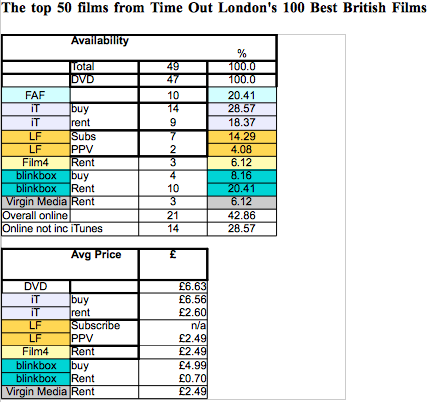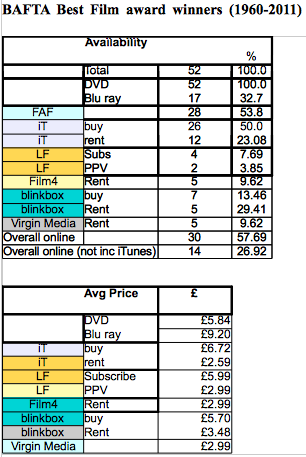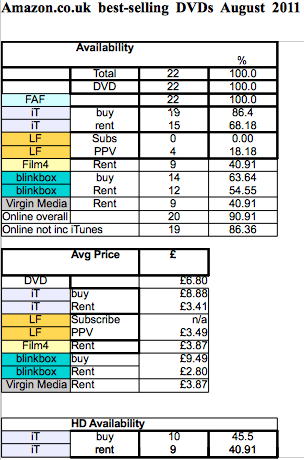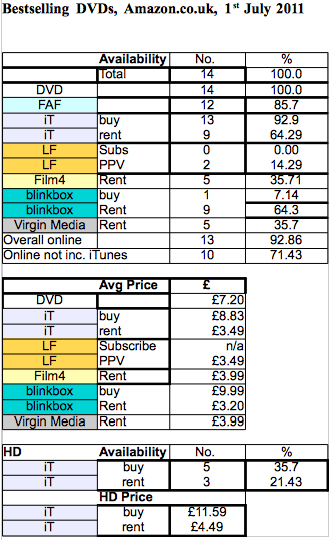Can’t look now: finding film online
Last week YouTube announced the opening of its movie rental service. This could be great news for film lovers, offering easy access to the films they want to watch. Exactly how useful this is to consumers depends somewhat on how many films are available through the service.
The availability of legal content online has featured heavily in discussions about the digital economy, most recently in the ongoing roundtables, hosted by the Minister Ed Vaizey MP, about new website blocking powers over sites involved in copyright infringement. The question is whether consumers’ demand for films, music and other goods is being satisfied.
ORG, and others such as Consumer Focus, believe that more attention needs to be paid to how well the markets for films and music are serving consumers before we assume that certain kinds of enforcement measures are necessary and proportionate. We want to see thriving and innovative cultural markets that help creators and consumers get the best out of new technology.
In this context, and against the backdrop of the recent injunction won by the film industry that requires BT to block the website Newzbin2, we decided to have a look at the availability of films online. We looked at how many of the recent best-sellers and catalogues of critically acclaimed films, including the top 50 British films, consumers can legally buy or rent online. We searched five content providers, and looked at rental and purchasing prices, and compared them with DVD availability and prices.
Our experience points to a lack of availability, poor pricing and quality issues when compared with physical media. In short, we found a situation that indicates serious problems with the licensing of films for online providers. (See bottom of the post for more on what we did and tables of what we found.)
Poor availability
Given the scope of our work and the way catalogues available in these services frequently change, these results should be seen as indicative only. They point at the questions policy makers should be asking about cultural markets online. What they indicate is not good news for consmers. Anybody who has tried renting or buying films online will probably be unsurprised at what we found.
DVDs are available for just shy of 100% of the films. But a wealth of British cultural history is simply not available through legal providers. Only 43% of the top 50 British films can be bought or rented online. Similarly, only 58% of the BAFTA Best Film award winners since 1960 have been made available.
The situation looks worse if iTunes is discounted. Excluding iTunes, only 27% of the BAFTA award winners are available, with 29% of the best British films. Only 6% of the best 50 British films are on Film4 OD or Virgin Media, with 14% available through a LoveFilm subscription and 4% through pay per view on LoveFilm.
Availability is better for recent best selling releases, but it is still very patchy. Some 86% of the best selling films on Amazon.co.uk in August 2011 can be bought on iTunes, but only 63% on blinkbox. There are few other means to purchase digital versions of films online. Furthermore, purchasing films on blinkbox for the most part means purchasing unlimited access to a stream. Only some are available to download, and for PCs only, meaning access is, for many, dependent on blinkbox’s continued existence.
Rental services fare worse – 64% of the films are available to rent on iTunes, 18% are available on Lovefilm pay-per-view, 55% on blinkbox and 41% on Film4 OD and Virgin Media.
Price and quality
Digital prices do not compare favourably to those of DVDs. For the best selling DVDs from August 2011 the average price was £6.80. For iTunes purchases, of the films available through it’s service, the average price was £8.88. For blinkbox purchases the price stood at £9.49.
Of the 14 of the 49 best British films available to purchase on iTunes, the average price is £6.56, while for DVDs the average price is £6.63. DVD prices for the BAFTA winning films average at £5.84, whilst on iTunes the average price stands at £6.72. For the 7 of those films available on blinkbox, the average price is £5.70.
The quality of films available online also does not compare well with physical media. Standard definition tends to be just short of DVD quality across the content providers. HD film purchases and rental are available on iTunes only, with 45.5% of the best selling DVDs from August available to buy (at an average of £11.59) and 40.9% to rent (at an average of £4.49).
There are also problems with the flagship service Findanyfilm.com. In our searches we found discrepancies between the results shown in Findanyfilm.com and the results from searching content providers themselves. This is a potentially brilliant service and could be an essential tool for consumers. However it is currently let down by inconsistent and inaccurate results.
The is a picture of a patchy market place that serves fewer films at equal or higher prices to the DVD market. A lack of high quality streaming services are clearly partly determined by bandwidth issues. However, the findings point at problems with licensing, rights clearance and distribution arrangements alongside a reluctance from rights owners to sanction broad digital availability. The film market online is dominated by one service and overall offers a poorer selection, higher prices and lower quality than the physical media market. It is not a compelling consumer offer.
This shouldn’t be read as a criticism of content providers, film makers or the film industry. It is instead intended to demonstrate that there are obvious problems with the licensing and availability of films online. If the goal for policy makers is cultural markets that thrive in the digital age, then a vital element of this must be ensuring that consumers’ demand is satisfied online. Clearly this is not yet happening.
The implications
Consumers have moved online faster than the film industry whose films they want to watch. They are being confronted with the equivalent of empty shelves. It is unsurprising that many people have found ways of discovering and watching films online from unofficial channels. Blocking all the sites that offer non-licensed content in the world – presuming this could be done successfully in practice – would not improve a consumers chances of buying a film online that is not for sale.
Presuming a decline in physical media sales, shifts towards digital consumption and device ‘convergence’, the availability of a broad digital catalogue of works at least comparable to that available on physical media will be vital in sustaining a bouyant film industry.
In the US, DVD sales fell 20% in the first quarter of 2011. The European Retailers Association’s ‘Video Market’ report for 2010 notes a ‘10% decline in DVD volumes, much of that decline concentrated in the area of older catalogue titles’, and that ‘overall (in 2010)…videos new growth formats (Blu-Ray and digital)…accounted for just over 13% of the market’s value, not quite enough to offset the declines in DVD, but a far healthier position than in 2009.’
In their proposals for a new website blocking scheme industry bodies argue their approach ‘begins with a commitment to ensuring that there are legitimate offers in the marketplace, adapted to the changing opportunities provided by digital technology’ (A copy of the original proposals is available here on the Open Rights Group wiki).
However the proportionality and necessity of enforcement measures can only be considered in a situation in which there is a compelling offering of legal services and a healthy market environment. Before damaging new enforcement measures are on the table, policy makers need to ensure that consumers’ demand is being satisfied online.
What are the drags on the market?
It is likely that new formats such as Ultraviolet, which is a format for films that allows consumers to view a film on a number of permitted devices through a cloud-stored copy, and the likely emergence of Netflix in the UK will help widen availability. Netflix became the highest user of bandwidth in the US, overtaking BitTorrent, in May this year.
Ultraviolet could be a popular and in some ways a consumer-friendly format. However, as with all Digital Rights Management formats, close attention should be paid to the effects on both consumer rights and innovation. For example, there will likely be follow-on impacts on device manufacturers and content providers, and consumers may experience compatibility issues with their devices. Recent research from Rice and Duke Universities in the US suggests there is some truth to what many have suspected for some time – Digital Rights Management does little to prevent copyright infringement and does a lot to punish legitimate consumers.
Despite these forthcoming changes, these results suggest deeper problems. They suggest that complex market relationships, comprised of myriad rights deals and varyingly compatible technical standards, can fragment and balkanise a marketplace.
They also suggest a reticence to engage with digital markets. runs contrary to the Government’s aims as stated in their growth strategy (“The path to strong, sustainable and balanced growth”, HM Treasury and BIS, November 2010, p. 9, available here), as they seek:
“…a dynamic business environment, driven by open and competitive markets. Incumbent firms need to be constantly challenged to improve and new ideas must be allowed to enter markets.”
These are the issues that policy makers should be pressing the industry to overcome. There are signs that policy makers are beginning to pay more attention. The ‘Hargreaves Review’ of IP and Growth took a refreshing frame of innovation and economic growth, with ideas to promote better markets through, for example, a ‘Digital Rights Exchange’. The Competition Commission’s recently found that Sky’s deals with major studios restricted competition for services offering new release films, and distorted the Pay TV market. DCMS have an ongoing film policy review. And the EU have an ongoing consultation on ‘online distribution of audiovisual works in the European Union’, suggesting a welcome focus on the digital single market, which takes on some of the themes from it’s new IP Strategy.
In all of these, we hope that copyright infringement is trumped by a proper look at the health of online markets as the defining frame. Markets need to be fair and open, with a healthy wholesale market and non-discriminatory copyright licensing. This would be a more effective way of helping content industries adjust to, and capitalise on, the opportunities of the digital age than overly aggressive protection and enforcement.
Our search results should be taken as indicative – it is a limited sample of films and the catalogues of films available at each provider changes frequently. But whilst there are such obvious deficiencies in the market for cultural goods online there should be a moratorium on new enforcement measures. This should begin with the abandoning of discussions about new website blocking powers, which are currently being entertained by policy makers in DCMS. Furthermore, understanding the factors that influence the health of markets for films should be a key focus of the ongoing film policy review.
Notes on the results
The four film lists we used:
- The top 50 films from Time Out London magazine’s 100 Best British Films
- BAFTA Best Film award winners (1960-2011)
- Amazon.co.uk’s 20 best-selling DVDs as of 1 July 2011
- Amazon.co.uk’s 40 best-selling DVDs for August 2011
For each film, we searched five content providers (iTunes, Lovefilm, blinkbox, Film4 OD, and Virgin Media) and one film listing service (Findanyfilm). Box-sets and TV shows were excluded from the comparison of the Amazon.co.uk lists. For the recent best sellers lists, we included HD results.
The results for any given search frequently change, with content providers’ catalogues changing offers. Results here should therefore be taken as *indicative* of current availability. You can download the spreadsheets with more detailed comparisons in here (.xls)




